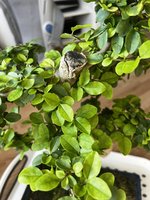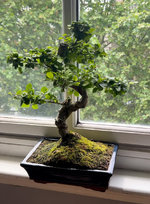Welcome! You got this tree from a great source. Greenwood Bonsai has been around a very long time. Corin Tomlinson is well known, even here in the states. His dad Harry's book "The Complete Book of Bonsai" published back in 1990 was an entry point for me back then to do bonsai.
You made a good choice in starter material as well. Privet are very hardy and forgiving as bonsai, but they (and most other bonsai species-unless they're tropical species) don't do very well indoors. They weaken and eventually die. Keeping any bonsai inside requires know how and complicates care dramatically, particularly if you're a beginner. It adds another layer on an already steep learning curve. Best to get it outside (if possible) into a partially sunny spot (four hours morning sun, afternoon shade is optimal.
Your first step in learning bonsai is not design. It's keeping the tree alive and healthy. That requires getting the knack of watering, which is THE hardest part of bonsai. Watering is a skill you have to learn. It's done only when the TREE needs it, not when you can get around to it or when you schedule it. Bonsai are quite like dogs and cats. They need what they need, when they need it. Dogs and cats can be more forgiving in their needs and your schedule, but your tree isn't, unfortunately.
You have to learn when the soil is likely to dry (it can vary day to day). Some days when it's humid and still, the tree won't need any water. Some days that are dry and windy and depending on the soil volume and foliage load, your tree may need watering two or even three times. This can be determined a couple of easy ways--first is the chopstick method. Stick a wooden chopstick down into the soil from above half way between the tree's trunk and the edge of the pot so the tip is half way between the soil surface and the bottom of the pot. Leave it there. When you want to check soil moisture, pull the stick up and look at the end. It should show moisture at the end inch or so. If it's wet, you don't need to water. If it's dryish--you need to water.
Another method is lifting the edge of the pot up to gauge weight--a well-watered pot weighs significantly more than a pot that needs water. The soil in the pot holds onto water and gradually gives it up over time. So, to begin, water your bonsai until water freely flows out of the drainage holes. Then lift one end of the pot up about an inch or three. Feel the weight? That's what a pot that doesn't need water feels like. Over the course of a day, lift the pot the same way a few times. It should feel lighter --it's a game of estimation at first. Over time, you will be able to gauge the weight of a full vs "needs water" pot easily. Along the way, notice the color of the soil surface--drying bonsai soil tends to be a lighter color than wet bonsai soil. That's another way to tell.
Thickening the trunk in this pot won't be easy--the principle of bonsai cultivation is that the pot restricts growth, which keeps the tree from growing rampantly. Once a bonsai subject is placed in a pot, generally the desired trunk diameter has been reached (in the ground, or a substantially larger container) and the development of branching is begun. I doubt you will be able to thicken this trunk much more in this container. It will, of course continue to thicken (trees add a layer of cambium under their bark every year), but it won't be all that noticeable for quite some time. If you want faster thickening you can put it into a larger growing container, or plant it out in the ground and allow it to grow rampantly without trimming for a while (three years at the minimum, any less time and you won't see much if any difference). This free growth means the tree will add substantial top growth, that growth will require larger pathways to exchange nutrients with the roots--expanding the trunk. However that unrestricted growth means you lose the finer ramification, smaller branches and smaller leaves that are the result of pruning, pinching , etc. All that has to be restored when the trunk is again dug up and put in a smaller container once the desired trunk diameter is reached.
If you've noticed--Bonsai is a practice of trade offs.
The tree you have has already undergone all of this and has been repeatedly shaped with hard pruning and pinching of new growth. It will revert to larger leaves and coarser branching if you DON'T keep shaping it this summer. You can further develop the branching. The lowest branch is a new one--straight as an arrow with foliage at the end. Branching on deciduous trees is developed through series of hard prunings and grow-out periods. THere are a few ways to do it--wire can be an option, but be warned, wiring deciduous branching can break it easily. These finer details are explained in many publications and online (here included--look up "hard pruning" "clip and grow" to get started).


